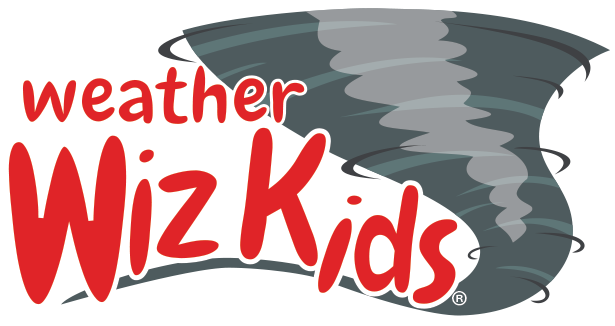Volcanoes
- Volcano Questions
- Types of Volcanoes
- Notable Volcano Eruptions
- Volcano Definitions
- Volcano Safety
- Volcano Activities
Volcano Questions
A volcano is a mountain that opens downward to a pool of molten rock below the surface of the earth. When pressure builds up, eruptions occur. Gases and rock shoot up through the opening and spill over or fill the air with lava fragments. Eruptions can cause lateral blasts, lava flows, hot ash flows, mudslides, avalanches, falling ash and floods. Volcano eruptions have been known to knock down entire forests. An erupting volcano can trigger tsunamis, flash floods, earthquakes, mudflows and rockfalls.
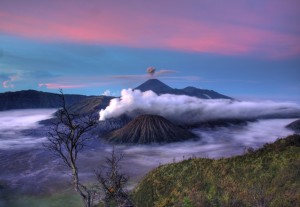
Click Here to learn more about volcanoes from USGS.
How are volcanoes formed?
Volcanoes are formed when magma from within the Earth’s upper mantle works its way to the surface. At the surface, it erupts to form lava flows and ash deposits. Over time as the volcano continues to erupt, it will get bigger and bigger.
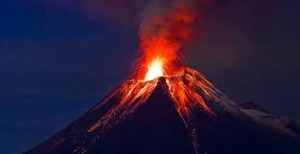
What are the different stages of volcanoes?
Scientists have categorized volcanoes into three main categories: active, dormant, and extinct. An active volcano is one which has recently erupted and there is a possibility that it may erupt soon. A dormant volcano is one which has not erupted in a long time but there is a possibility it can erupt in the future. An extinct volcano is one which has erupted thousands of years ago and there’s no possibility of eruption.
Why do volcanoes erupt?
The Earth’s crust is made up of huge slabs called plates, which fit together like a jigsaw puzzle. These plates sometimes move. The friction causes earthquakes and volcanic eruptions near the edges of the plates. The theory that explains this process is called plate tectonics.
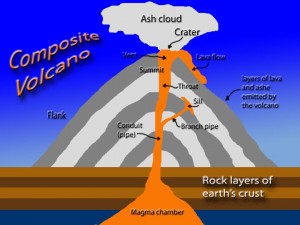
What are plate tectonics?
The theory of plate tectonics is a interesting story of continents drifting from place to place breaking apart, colliding, and grinding against each other. The plate tectonic theory is supported by a wide range of evidence that considers the earth’s crust and upper mantle to be composed of several large, thin, relatively rigid plates that move relative to one another. The plates are all moving in different directions and at different speeds. Sometimes the plates crash together, pull apart or sideswipe each other. When this happens, it commonly results in earthquakes.
Click Here to learn more about plate tectonics and the drifting of our continents.
How many volcanoes are there?
There are more than 1500 active volcanoes on the Earth. We currently know of 80 or more which are under the oceans. Active volcanoes in the U.S. are found mainly in Hawaii, Alaska, California, Oregon and Washington.
What is the difference between lava and magma?
Magma is liquid rock inside a volcano. Lava is liquid rock (magma) that flows out of a volcano. Fresh lava glows red hot to white hot as it flows.
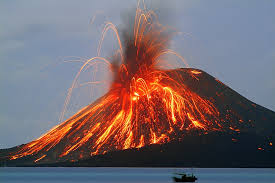
Why does lava take a long time to cool down?
Lava cools slowly because lava is a poor conductor of heat. Lava flows slow down and thicken as they harden.
What is a pyroclastic flow?
A pyroclastic flow is a fluidized mixture of solid to semi-solid fragments and hot, expanding gases that flows down the sides of a volcano. These awesome features are heavier-than-air emulsions that move much like a snow avalanche, except that they are fiercely hot, contain toxic gases, and move at phenomenal, hurricane-force speeds. They are the most deadly of all volcanic phenomena.
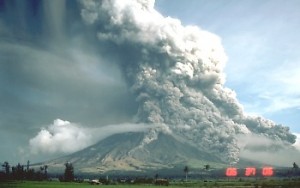
What is lahar?
A lahar is a type of mudflow or debris flow composed of pyroclastic material, rocky debris, and water. The material flows down from a volcano, typically along a river valley. It is very dangerous because it’s consistency and the way it acts is very much like cement. It is liquid when it’s moving, but when it stops, it solidifies. This can cause just as much devastation as lava itself.
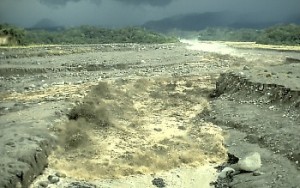
What is pumice?
Pumice is a light, porous volcanic rock that forms during explosive eruptions. It resembles a sponge because it consists of a network of gas bubbles frozen amidst fragile volcanic glass and minerals. All types of magma (basalt, andesite, dacite, and rhyolite) will form pumice.
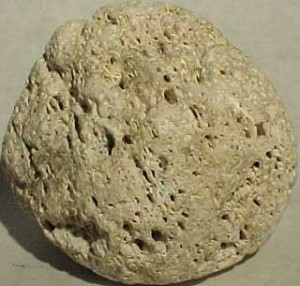
What is the largest active volcano?
The world’s largest, active volcano is Mauna Loa in Hawaii, where famous coffee is grown in the rich volcanic soils. Mauna Loa is 13,677 feet above sea level. From its base below sea level to its summit, Mauna Loa is taller than Mount Everest.
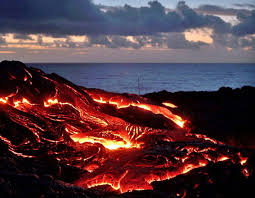
What is the Ring of Fire?
The Pacific Ring of Fire is an area of frequent earthquakes and volcanic eruptions encircling the basin of the Pacific Ocean. The Ring of Fire has 452 volcanoes and is home to over 50% of the world’s active and dormant volcanoes. Ninety percent of the world’s earthquakes and 81% of the world’s largest earthquakes occur along the Ring of Fire.
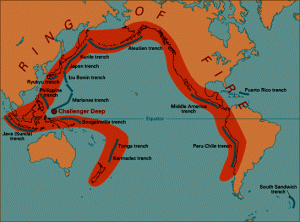
What is volcanic lightning?
Volcanic lightning, also known as dirty thunderstorms, is capable of producing some of the most powerful and visually striking lightning storms on Earth. Not all volcanic eruptions produce lightning. When it does occur, a single eruption can create multiple, separate lightning storms. The lightning seems to be set off by explosions during the eruption, although not all explosions cause lightning. During recent eruptions that displayed lightning, scientists observed the most intense lightning occurred at the beginning of the eruption and gradually decreased as the eruption continued, sometimes over a period of weeks.
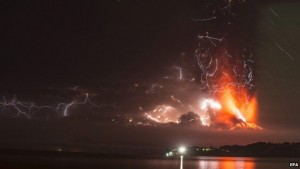
When is a volcano considered active?
Surprisingly, there is no consensus among volcanologists on how to define an active volcano. The lifespan of a volcano can vary from months to several million years, making such a distinction sometimes meaningless when compared to the lifespans of humans or even civilizations. For example, many of Earth’s volcanoes have erupted dozens of times in the past few thousand years but are not currently showing signs of activity. Given the long lifespan of such volcanoes, they are very active. By our lifespans, however, they are not.
What is a Vulcanian Eruption?
A vulcanian eruption is a type of explosive eruption that ejects new lava fragments that do not take on a rounded shape during their flight through the air. This may be because the lava is too viscous or already solidified. These moderate-sized explosive eruptions commonly eject a large proportion of volcanic ash and also breadcrust bombs and blocks.
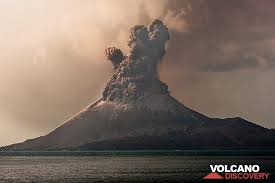
What is a mud volcano?
In volcanic regions, mud volcanoes are usually small volcano-shaped cones of mud. They are built as mud erupts from a vent, either as a flowing liquid or ejected into the air. The mud is formed as acid gases rise through the crust, react with rock and turn it into clay. The mud is a mixture of clay and groundwater. The mud volcanoes erupt following pressurization from geothermal steam and gases.
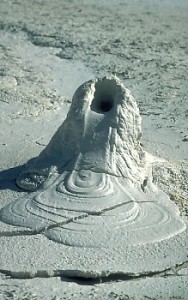
What is a tsunami?
A tsunami is a large ocean wave usually caused by an underwater earthquake or a volcanic explosion. Tsunamis are NOT tidal waves. Tidal waves are caused by the forces of the moon, sun, and planets upon the tides, as well as the wind as it moves over the water. With typical waves, water flows in circles, but with a tsunami, water flows straight. This is why tsunamis cause so much damage!
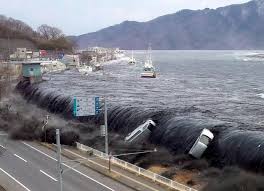
Click Here to see an animation of an earthquake and the resulting tsunami. It’s great for kids, because they get to see how it actually happens!
Click Here to get the latest tsunami warning information from the NWS.
Types of Volcanoes
Active volcanoes – Scientists usually consider a volcano active if it is currently erupting or showing signs of unrest, such as unusual earthquake activity or significant new gas emissions. Many scientists also consider a volcano active if it has erupted in historic time. It’s important to note that the span of recorded history differs from region to region; in the Mediterranean, recorded history reaches back more than 3,000 years but in the Pacific Northwest of the United States, it reaches back less than 300 years, and in Hawaii, little more than 200 years.

Dormant volcanoes – Dormant volcanoes are those that are not currently active (as defined above), but could become restless or erupt again.
Extinct volcanoes – Extinct volcanoes are those that scientists consider unlikely to erupt again. Whether a volcano is truly extinct is often difficult to determine. For example, since calderas have lifespans sometimes measured in millions of years, a caldera that hasn’t produced an eruption in tens of thousands of years is likely to be considered dormant instead of extinct. Yellowstone caldera in Yellowstone National Park is at least 2 million years old and hasn’t erupted for 70,000 years, yet scientists do not consider Yellowstone as extinct. In fact, because the caldera has frequent earthquakes, a very active geothermal system, and rapid rates of ground uplift, many scientists consider it to be a very active volcano.
What are the different types of volcanoes?
Volcanoes are grouped into four types: cinder cones, composite volcanoes, and shield volcanoes.
Cinder cones are circular or oval cones made up of small fragments of lava from a single vent that have been blown into the air, cooled and fallen around the vent.
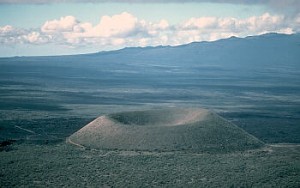
Composite volcanoes which are also called ‘stratovolcanoes’ are steep-sided volcanoes composed of many layers of volcanic rocks, usually made from high-viscosity lava, ash and rock debris. Mt. Rainier and Mount St. Helens are examples of this type of volcano.

Shield volcanoes are volcanoes shaped like a bowl or shield in the middle with long gentle slopes made by basaltic lava flows. Basalt lava flows from these volcanoes are called flood basalts. The volcanoes that formed the basalt of the Columbia Plateau were shield volcanoes.
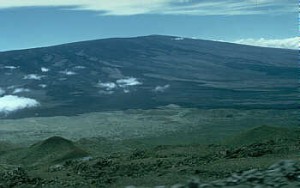
Notable Volcano Eruptions
When did Mount St. Helens erupt?
On May 18, 1980, Mount St. Helens erupted. It’s located in southwestern Washington State in the Cascade Range. The blast was heard as far away as Montana, Idaho, Canada and California. Fifty-seven people died and the eruption caused $1.2 billion in damage.

Click Here for more info on Mount St. Helens.
What are some other notable volcano eruptions?
Krakatoa was a dormant volcano in Indonesia, which awakened and produced one of the biggest volcanic eruptions in 1883. So massive was the eruption that the sound of it was heard as far away as Australia. It’s widely reported as the loudest sound heard in recorded history. The Krakatoa eruption created a huge amount of ash cloud which covered the Earth and reduced global temperatures for 5 years! A total of 40,000 people died in that explosion and an entire chain of the volcanic island was destroyed. For more info: Click Here!
Mount Pelee was a dormant volcano situated in the Caribbean island of Martinique. In 1902, it erupted in a massive horizontal explosion sending huge clouds of ash released towards the nearby town of Saint-Pierre. The side of the volcano exploded and lava flowed straight into the town, killing 30,000 people in a matter of minutes. It is regarded as one of the biggest and most devastating volcanic eruptions of the 20th century, a benchmark for future eruptions.
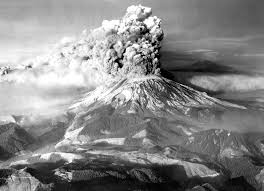
Mount Fujiyama, also popularly known as Mount Fuji, is an active volcano which last erupted in 1708. It is incidentally the tallest mountain in Japan. If you are visiting Tokyo, the capital of Japan, look in the west on a clear day and you will be able to see Mount Fuji. It is an iconic volcano. Mount Fuji is 3,776 meters high and it is snow clad throughout the year, with five lakes surrounding it. Currently in a state of dormancy, there has not been any eruption reported for more than 300 years. The last known eruption lasted for about 3 weeks during which it covered the surrounding villages with ash and cinders. Mount Fuji is now a popular tourist location with a large number of climbers actively scaling the mountain top.
Volcano Definitions
MAGMA – Magma is the liquid rock inside a volcano.
LAVA – Lava is the liquid rock (magma) that flows out of a volcano. Lava glows red hot to white hot as it flows.
ACTIVE VOLCANO – An active volcano is one that erupts regularly.
DORMANT VOLCANO – A dormant volcano is one that has not erupted for many years, although there is still some activity deep inside.
EXTINCT VOLCANO – An extinct volcano is a volcano that is no longer active.
GEYSERS – Geysers are springs that throw boiling water high in the air. They are caused by volcanic heat warming trapped ground water.
ASH – Ash are very small fragments of lava or rock blasted into the air by volcanic explosions.
PUMICE – It is a light-colored volcanic rock containing lots of bubbles from trapped gases.
BASALT – Basalt is a hard, black volcanic rock.
CALDERA – A caldera is a large, usually circular depression at the summit of a volcano formed when magma is withdrawn or erupted from a shallow underground magma reservoir.
ERUPTION CLOUD – A cloud of tephra and gases that forms downwind of an erupting volcano is called an eruption cloud.
FAULT – Faults are fractures or fracture zones in the Earth’s crust along which one side moves with respect to the other. A fault scarp is a cliff or steep slope that sometimes forms along the fault at the surface.
FISSURE – On volcanoes, a fissure is an elongate fracture or crack at the surface from which lava erupts.
PILLOW LAVA – When basalts erupt underwater, they commonly form pillow lavas, which are mounds of elongate lava “pillows” formed by repeated oozing and quenching of the hot basalt.
PRYOCLASTIC FLOW – A pyroclastic flow is a ground-hugging avalanche of hot ash, pumice, rock fragments, and volcanic gas that rushes down the side of a volcano.
TEPHRA – Tephra is a general term for fragments of volcanic rock and lava regardless of size that are blasted into the air by explosions or carried upward by hot gases in eruption columns or lava fountains.
VENT – Vents are openings in the Earth’s crust from which molten rock and volcanic gases escape onto the ground or into the atmosphere.
OBSIDIAN – Obsidian is dense volcanic glass, usually rhyolite in composition and typically black in color.
Click Here to see if there has been any recent volcanic activity across the U.S.
Volcano Safety
PLAN FOR A VOLCANO: First of all, have a disaster plan and know whether or not you are at risk for danger. Be prepared for mudslides, flash floods, earthquakes, ash falling, acid rain and tsunamis. Prepare a disaster supplies kit for your home and car. Include a first aid kit, canned food and a can opener, bottled water, battery-operated radio, flashlight, protective clothing, dust mask, goggles and sturdy shoes. Don’t forget, know all of your evacuation routes.
DURING A VOLCANO: Follow the evacuation order issued by authorities. Avoid areas downwind and river valleys downstream of the volcano. If your caught indoors, close all windows and doors, put machinery inside a barn, and bring animals inside. If you’re trapped outdoors, seek shelter indoors. If you’re caught in falling rocks, roll into a ball and protect your head. If you’re caught near a stream, be aware of mudflows and move to higher ground. Protect yourself when ash falls by wearing long-sleeved shirts and long pants. Use goggles to protect your eyes. Wear a dust mask and keep car engines off.
AFTER A VOLCANO: Cover you mouth and nose. Volcanic ash can irritate your respiratory system. Wear goggles and protect your eyes. Keep your skin covered. Clear roofs of ash, because the ash is very heavy and can cause the building to collapse.
Volcano Activites
Lesson Plan: Here are great lesson plans on learning more about volcanoes. These are great lesson plans for elementary school students.
Soda Bottle Volcano Experiment: Here is an experiment on how to make a soda bottle volcano with Mentos.
Baking Soda Volcano Experiment: Here is another experiment on how to make a baking soda volcano.
Science Fair Project Ideas: Here is a complete list of science fair project ideas. Discover the science behind the weather that impacts us every day.
